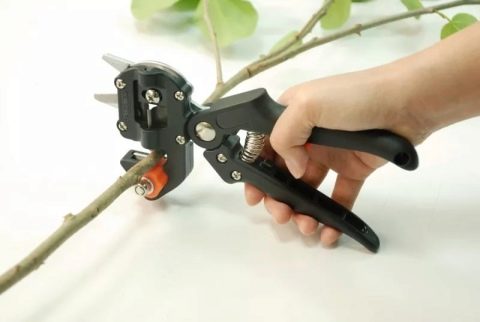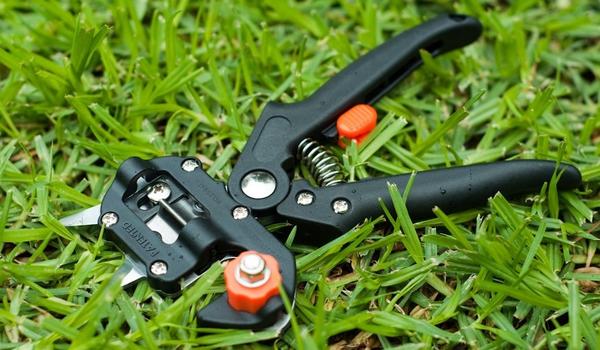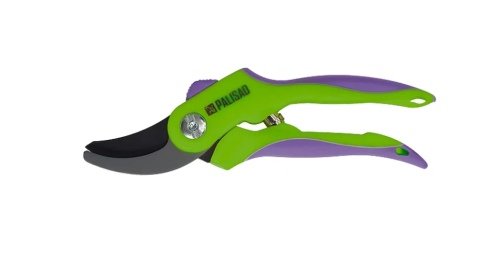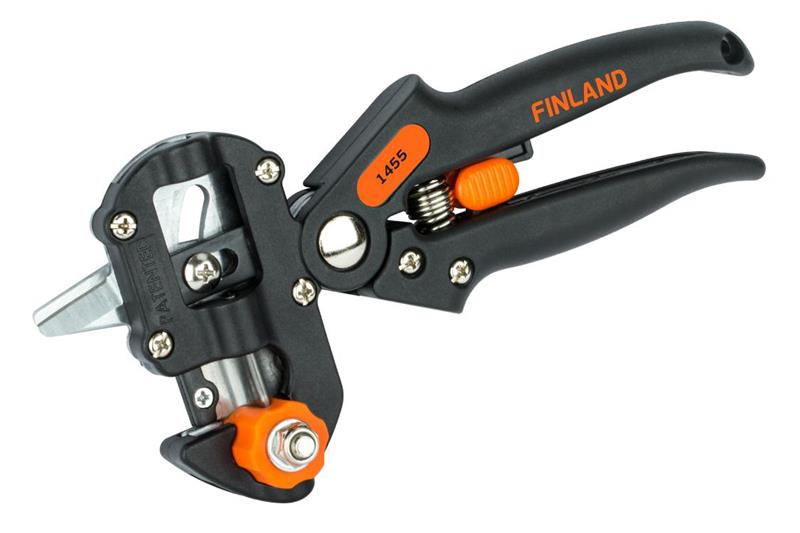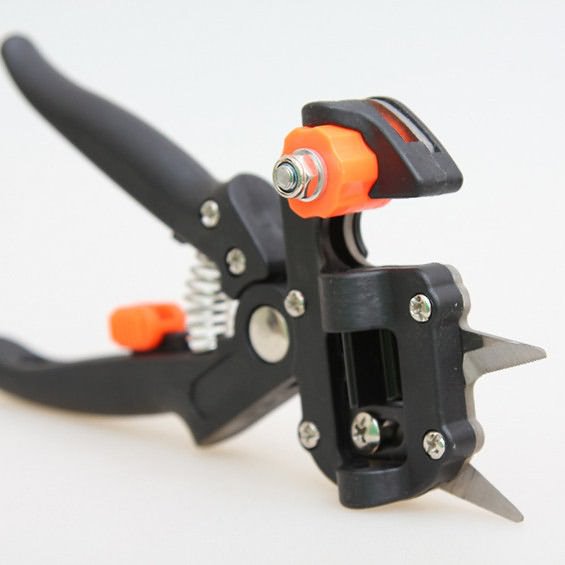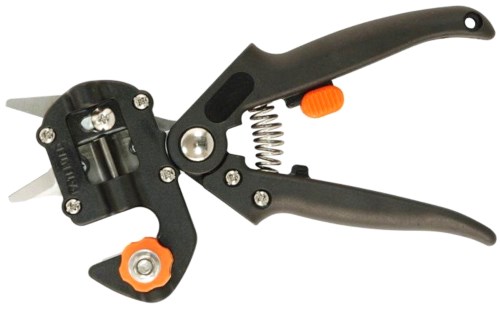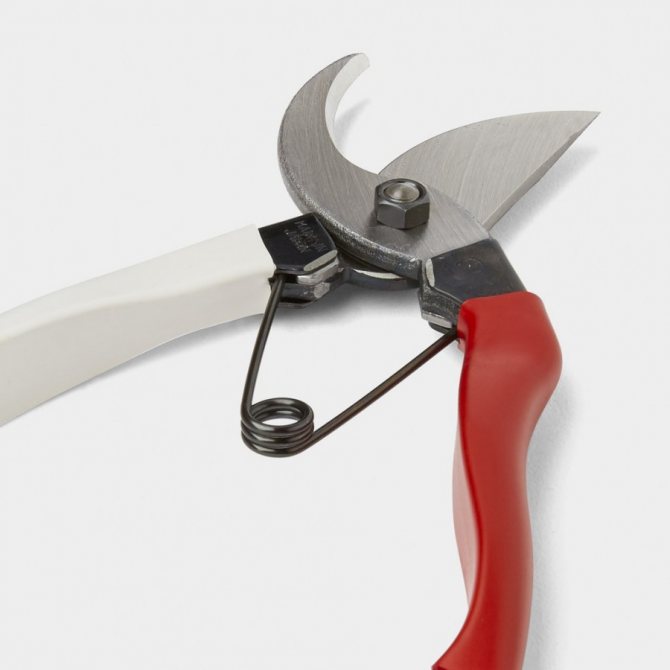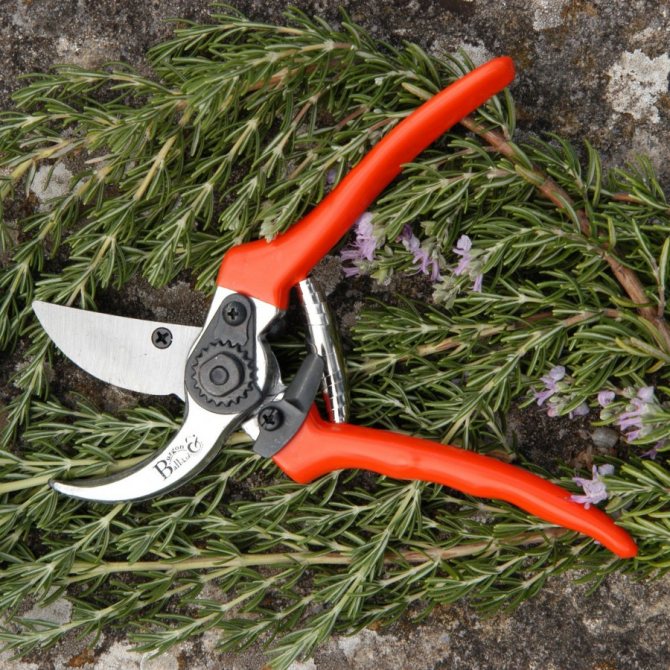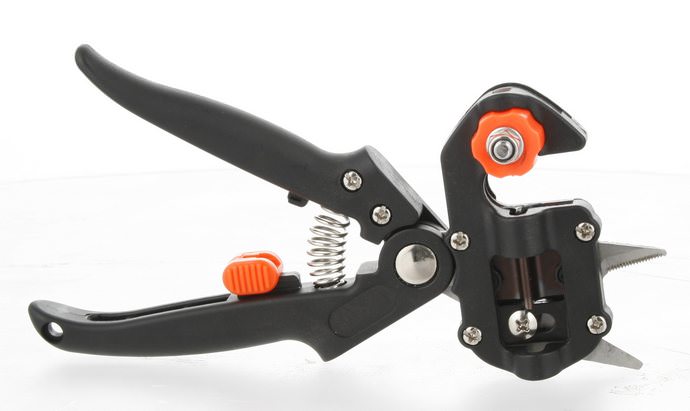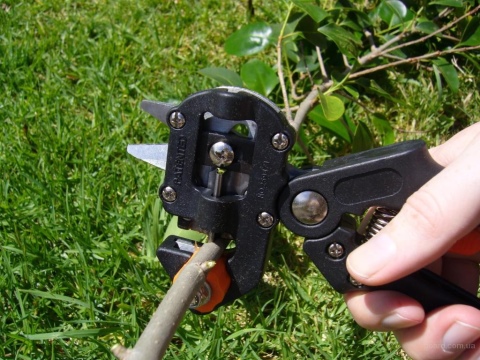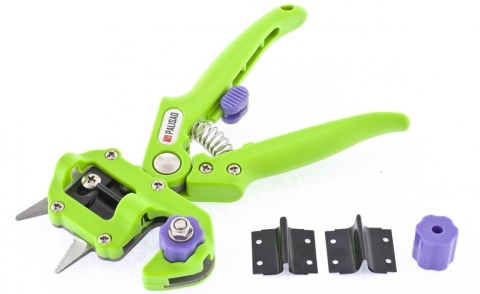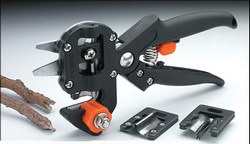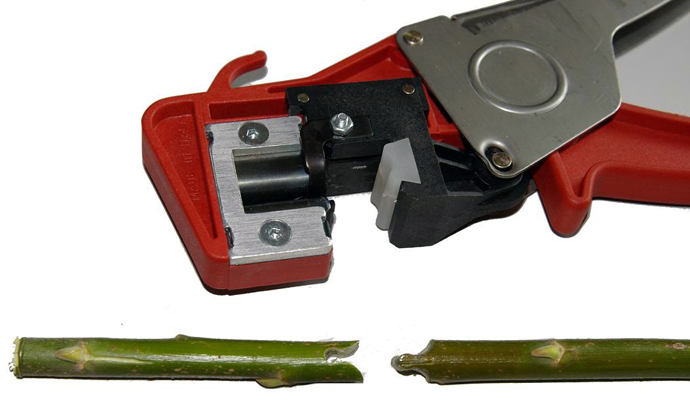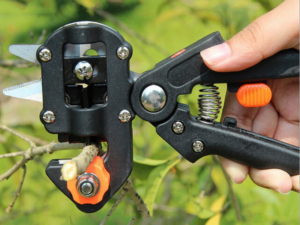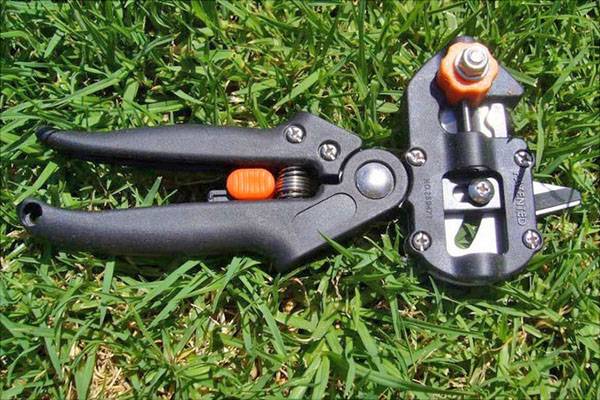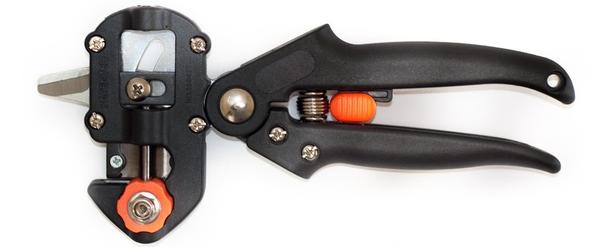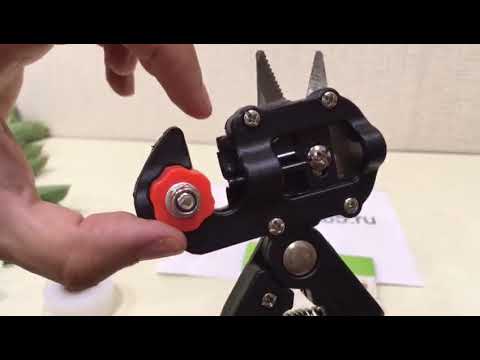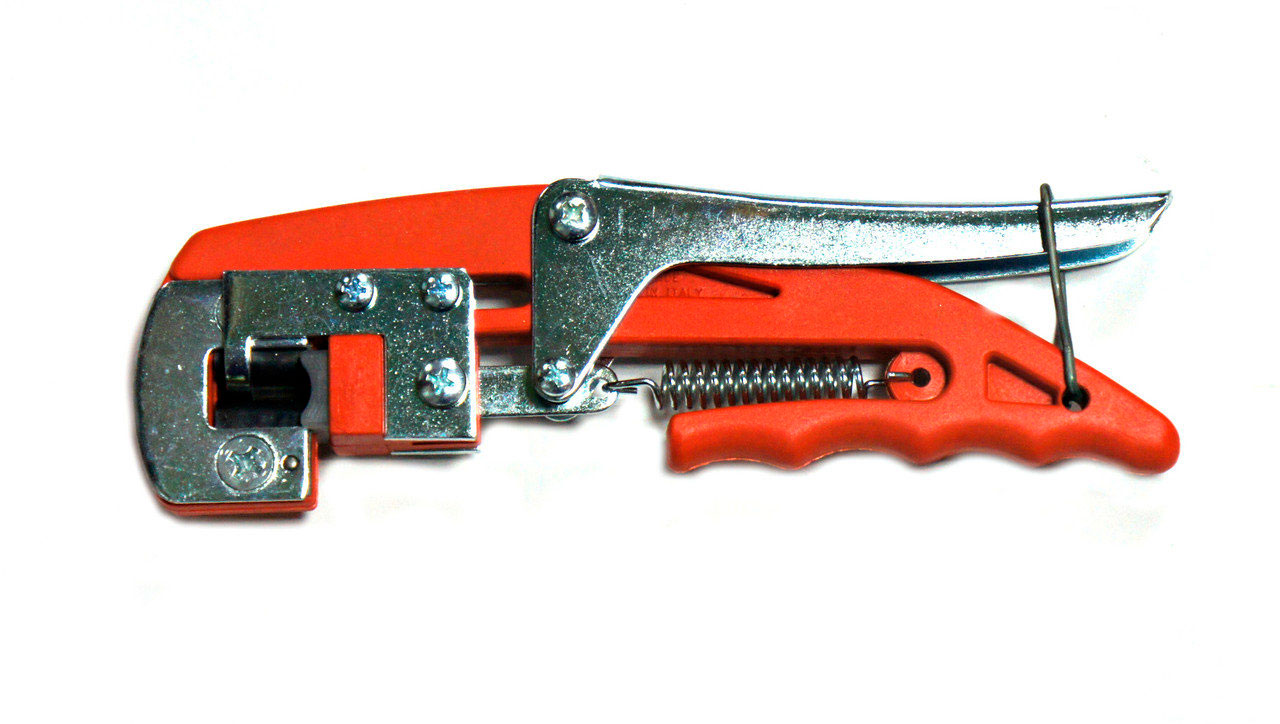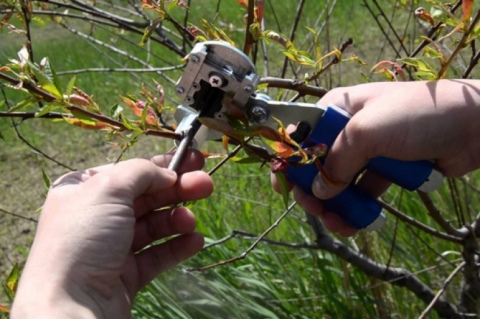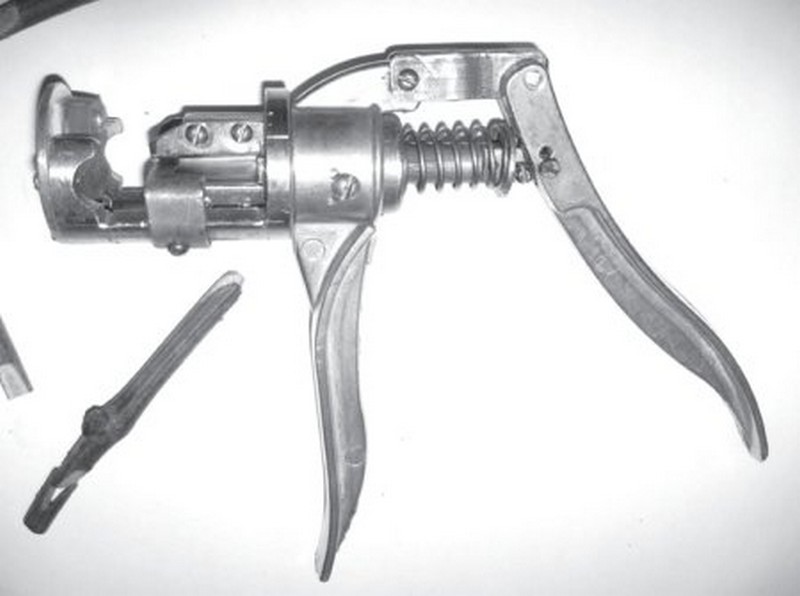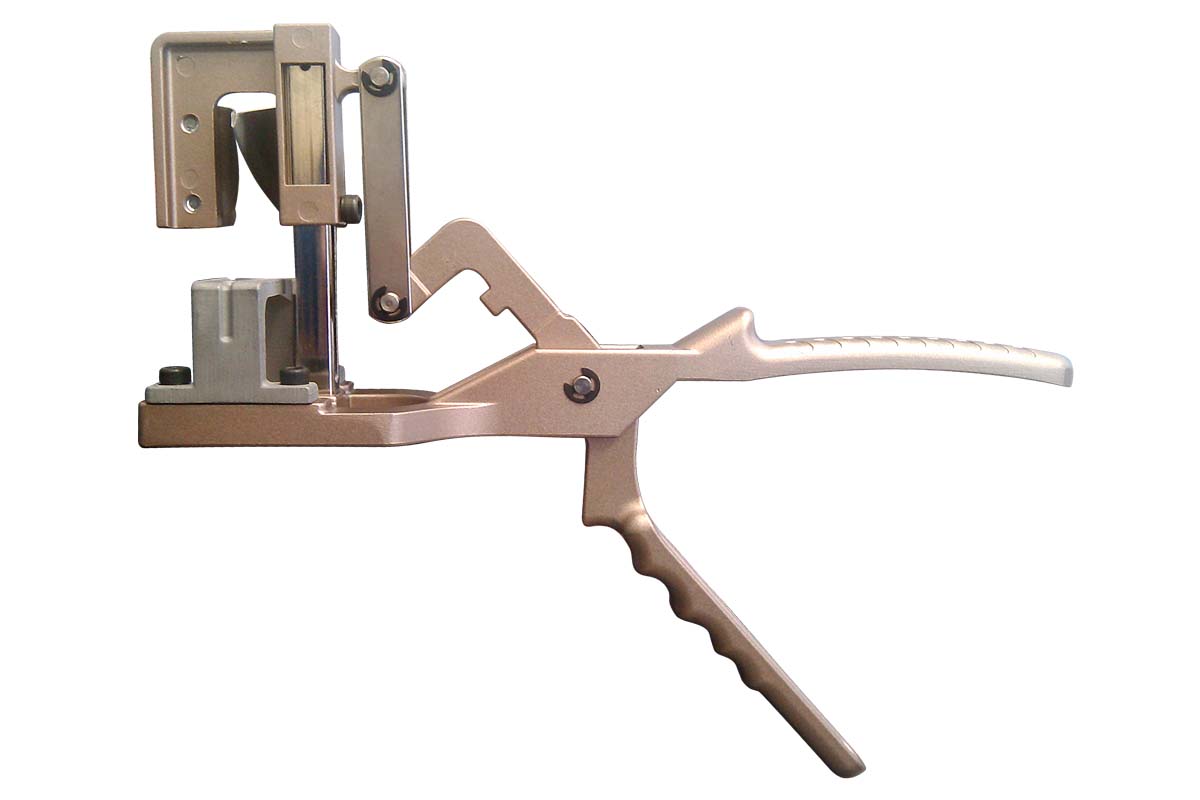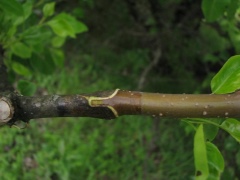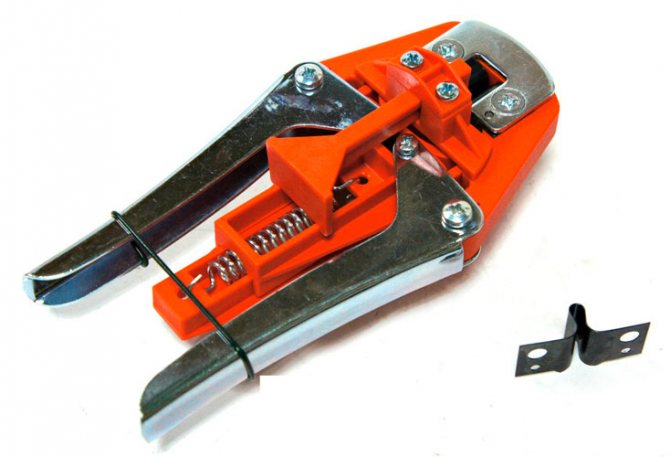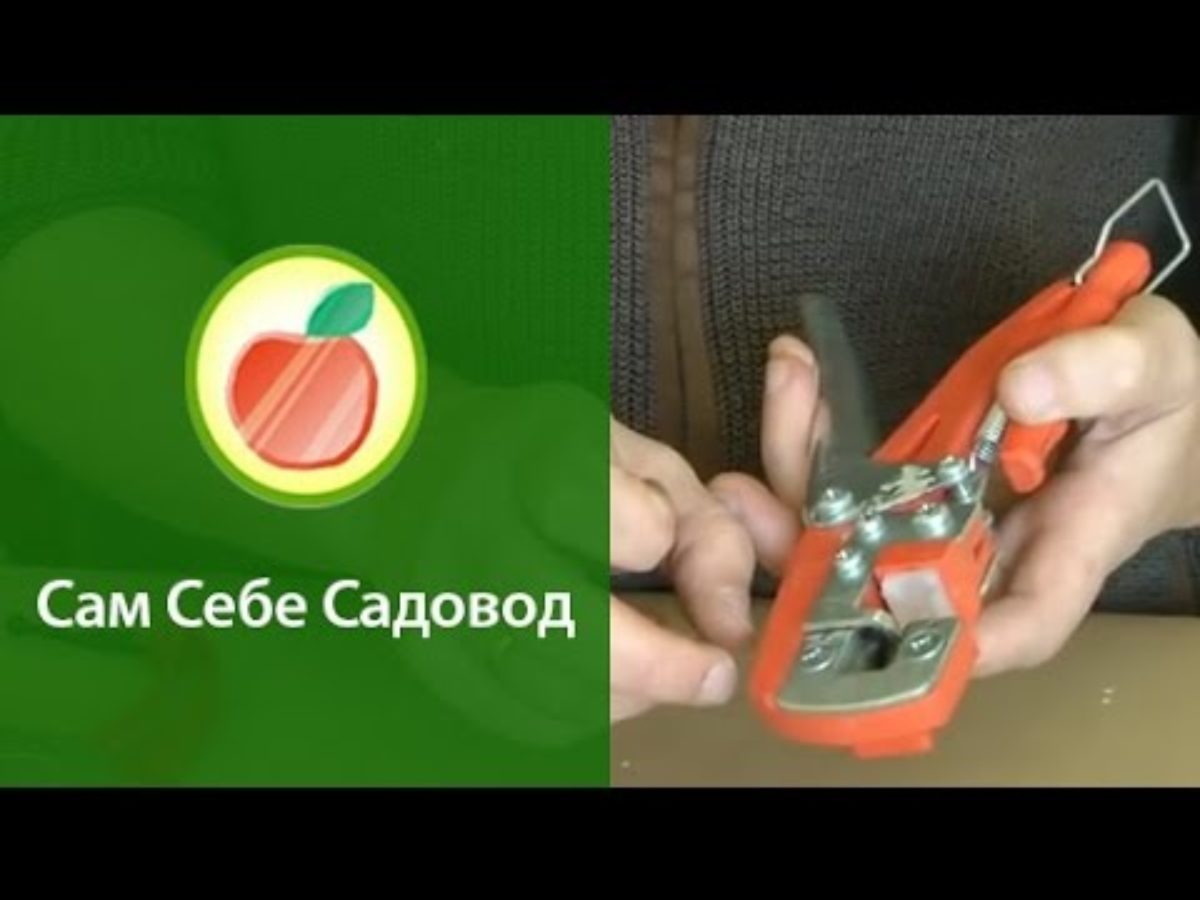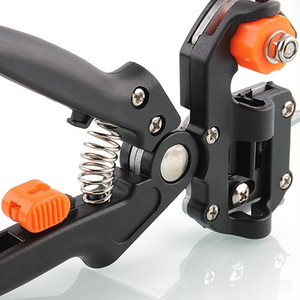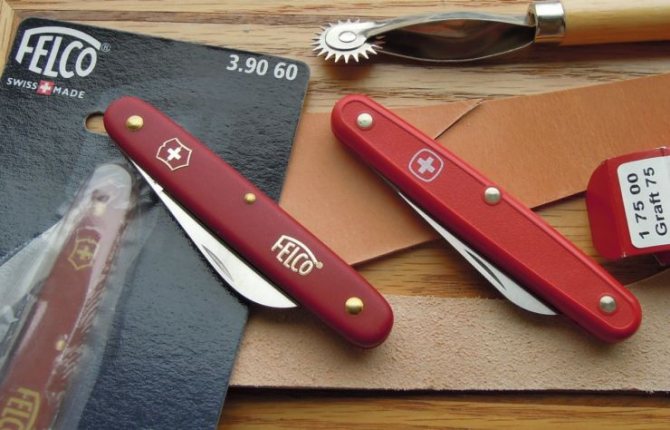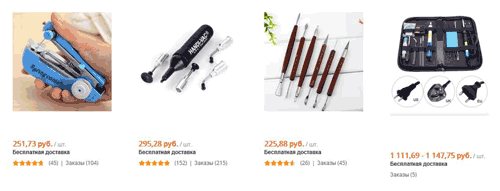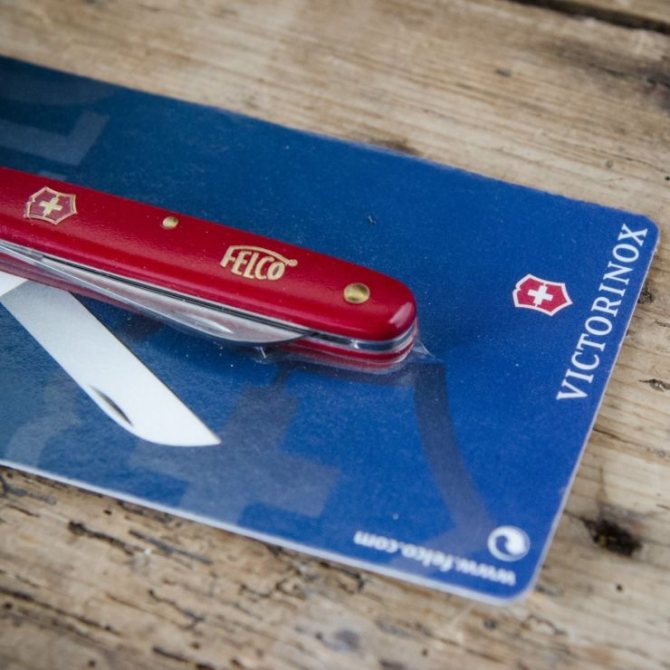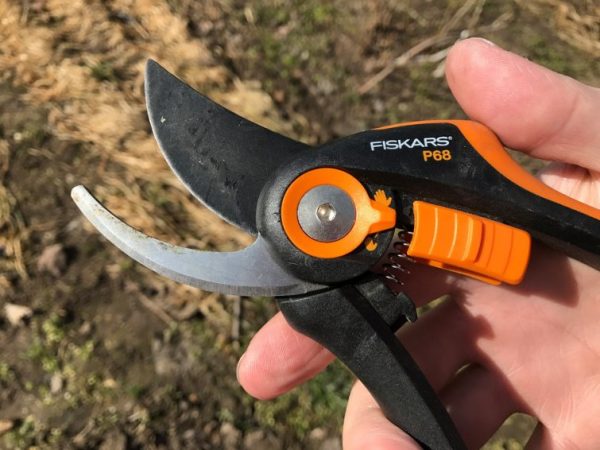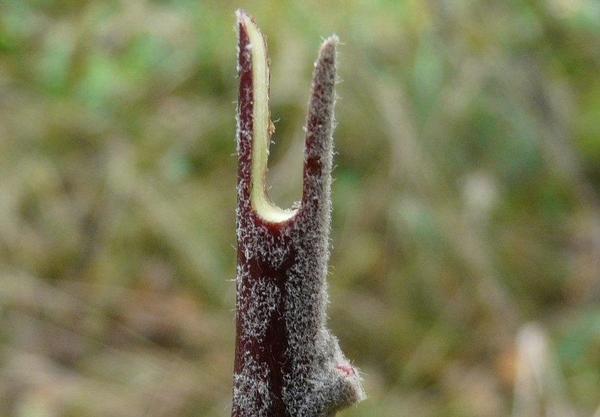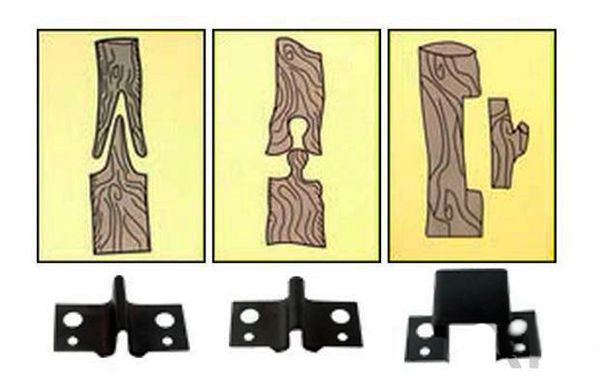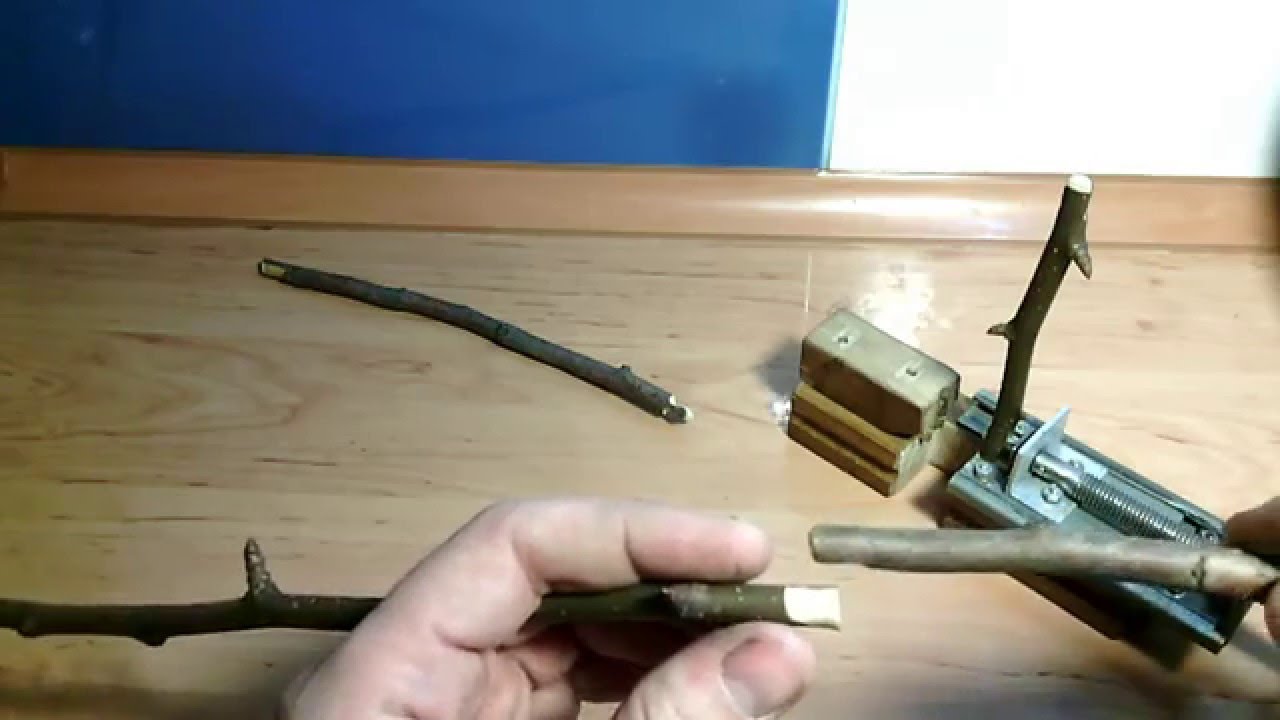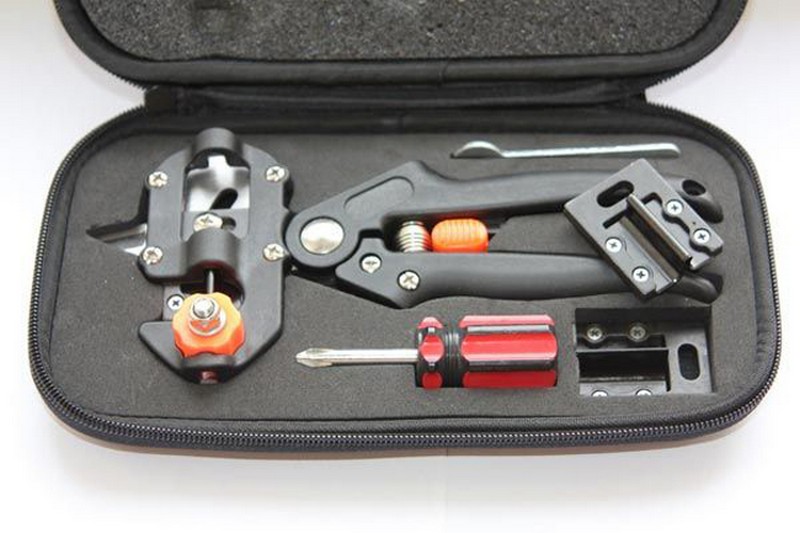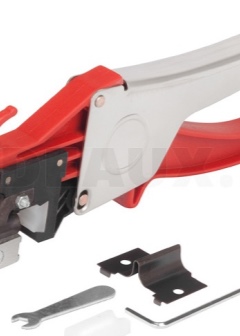Peculiarities
The grafting pruner consists of a working blade, a spring, a stopper and a comfortable handle. Some models are additionally equipped with a standard knife for pruning young cuttings. Such products are similar to pruning shears for garter grapes, but the main difference between such a cutting blade is its configuration - it is bent so that you can get a figured cut.
Depending on the type of this cut, knives of several types of replaceable blades are distinguished:
- V-shaped.
- U-shaped.
- Ω-shaped.
It is no secret that the success of grafting is largely due to the accuracy of the coincidence of the sections on the rootstock and the scion, which is why the design of the cutting part of the secateurs is made in such a way that the sections coincide without any further adjustments. Secateurs are professional, can be equipped with a power drive, contact or lever mechanism. Regardless of the type, the blades are made from high-carbon hardened steel, as a rule, they are well sharpened. The vaccine sectors have many advantages, among them the following can be distinguished:
- the grafting process lasts only a few minutes, so a significant number of plants can be processed in one day;
- thanks to the pruner, not only young annual shoots can be grafted, but also older and, accordingly, thick;
- secateurs are made from the most modern materials, so the tool does not lose its performance for several years.
And also pay attention to the fact that such a device is suitable for grafting branches of 4–12 mm. If the shoots are thinner or, conversely, wider, then it is better to use other devices, since secateurs have their own technical limitations.
Users also note some of the disadvantages of secateurs.
- Of the three types of knives included in the kit, the most effective is the omega-shaped one (Ω), since it forms a lock connection between the stock and the scion, so grafting can be done with both hands. However, this knife is not suitable for thin shoots. But the V-shaped device often gives an insufficiently strong connection, so the scion does not hold tightly enough, it has to be wrapped with one hand and this can be quite inconvenient to do.
- Pruners cut the wood across the grain, so the knives quickly become blunt, which leads to the fact that the edges of the cuts are crushed, and the fibers are soaked, so most models simply do not withstand the vaccinations declared by the manufacturer in number of 1,000 or more.
- Replacing knives is not an easy procedure, it requires some effort and time - it is carried out using two screwdrivers of different sizes, and also using pliers and keys. But not every garden plot has such a set of tools. That is why professionals advise to purchase two secateurs so that if one fails, you can continue to work with the second, and then carry out all the manipulations necessary to replace the blade.
- With the help of a pruner, the cut comes out shortened - no more than 1 cm, so there are many breaks in the grafting area, therefore, in this the tool is significantly inferior to simple grafting knives, since the latter allow making a cut of up to 4-5 cm. Many gardeners note after a while that at the site of inoculation, performed using a pruner, a characteristic growth appears. When using a knife, nothing like this happens, the boundaries of the accretion are almost invisible to an outsider's eye.
- Vaccination work carried out with the help of a pruner is rather limited in time - as a rule, from the very end of April to May 10. They can not do the pruning, therefore, the purchase of a pruner should not exclude the purchase of a knife, rather, supplement it.
Subtleties of choice
What to pay special attention to?
Blade travel
The path of the blades should be as tight as possible so that there is practically no gap between them. Otherwise, the branches will crumple and deform, which contributes to their further death.
Material
The best, most reliable blades for long tool life - Teflon coated or alloy steel. Yes, they are quite expensive, but in this case the price is fully justified.
Fastening reliability
This is already a safety issue that must be a priority. The blade must be firmly fixed. If it slips out during vaccination, given its severity, it can cause serious injury.
Pungency
In the store, grafting secateurs should be sold perfectly sharpened so that you don't have to face the difficult sharpening process in the near future.
Spring mechanism
The comfort of your work with the grafting pruner will depend on this criterion. The spring connects the handles and is responsible for the applied forces when pressed on them. Choose a belt mechanism that does not require much tension, but at the same time is reliable and durable.
Comfortable grip
First, it must be rubberized. This will prevent calluses from forming on the palms and will prevent fogging from slipping. Secondly, for comfortable work, it is good if there is a small hole in the lower handle for a convenient location of the finger in it.
Blade thickness
Experienced gardeners recommend purchasing a grafting pruner with blades, the thickness of which will be maintained in the range of 1.5-2 mm.
Examination
In specialized stores, they offer to see firsthand how a grafting pruner works, even before purchasing. In particular, paper is given, and the buyer makes the cut himself. In this case, you need to look at the place of the cut - it should be as even as possible. If the paper tears and comes out with jagged edges, you should keep looking for the perfect option.
About types and use
If you think that all pruners are the same, then you are wrong. After all, they all cut in different ways and are designed to perform different kinds of work. Therefore, it is worth dividing the secateurs into types such as:
- Plane.
- Contact.
- Scissors.
- With ratchet mechanism.
Consider each of these types in more detail.
Plane secateurs
Gardening tools of this kind are easily recognizable by the fact that they have moon-shaped blades that are offset in relation to each other. These pruners are designed to cut raw, that is, green branches. The tool blades are designed like this - the upper one is sharply sharpened, and the lower one is blunt and serves as a support.
The blades of the support secateurs complement each other perfectly. The lower blade supports and sometimes fixes the branch, the upper does its job, that is, cuts off the unnecessary part. As a result, the cut is very clean. In some cases, the support part of the secateurs is equipped with a groove that is designed to drain the juice. This prevents the mechanism from sticking.

Contact Tool
Pruners of this type are also called "with anvil" and they are intended solely to work with dry branches. This is because their direct action is not so much cutting as breaking off, roughly, like cutting with an ax. Such a tool also has only one working knife, which in the process of work abuts against a wide and very strong plate, that is, an anvil.
It is worth noting that the contact pruner is characterized by a wide opening of the blades.Therefore, with its help, "cut off" even dry branches with a high degree of rigidity and a fairly significant diameter. As for such a tool. At the same time, it is impossible to use such a pruner to trim green branches, since for the plant it will be a real torment, which will entail the formation of lacerations at the site of the cuts.
Scissor pruner
Such a tool differs from the two previous types in that both blades are sharpened and sharply sharpened and in the process of work they move towards each other. Moreover, the movement is performed in one plane. With the help of such a pruner, you can trim hedges, grass, young twigs and everything that has a diameter of no more than 1.5 centimeters in thickness.
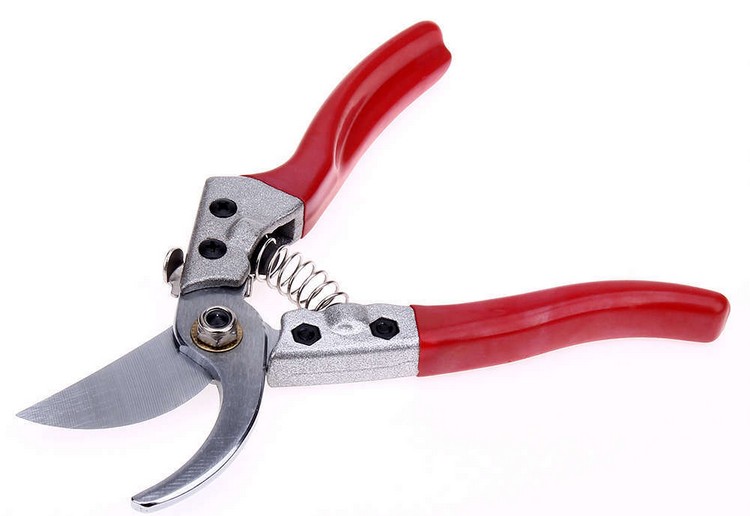
Here it is necessary to add that the scissors-pruners are also different in terms of shape. Therefore, this nuance should also be taken into account in the selection process. So, the pruner, which is designed for pruning grapes, has very "slender" blades, narrowed upwards.
Ratchet tool
The secateurs, which are equipped with a ratchet mechanism, are tools for those cases when the three previous types did not cope with the task. For example, for those cases when you need to cut a very powerful knot, but you can't do it the first time with a regular pruner.
What is the difference between ratchet pruning shears and conventional pruning shears? And everything is very simple. When working with particularly stubborn shoots, the gardener presses on the handles and the blades close on the branch. Then the person releases the handles, they return to their original position, and the blades remain on the branch, clamping it. By pressing the handles a second time, the gardener drives the blades even further, that is, deeper into the wood. And so on until the branch is finally cut off.

The principle of operation of the secateurs with a ratchet mechanism is stepwise with increasing force. At the same time, the gardener may not be afraid to "overexert himself." The thing is that the ratchet mechanism significantly reduces the load on the hand. At the same time, it copes well with both green and dry branches, the diameter of which reaches four centimeters.
Criterias of choice
In order to purchase high-quality garden tools, when choosing, you need to pay attention to a number of very important points.
Sharpness of knives. Care must be taken to keep the blades sharp. Some manufacturers produce pruning shears whose blades are treated with Teflon, electrophoresis, or made of alloy steel. All this has a very positive effect on the convenience and durability of this garden tool.
It is also important to check if the blade adheres well to the handle.
The type of spring that connects the pruning shears to each other is very important in the use of the tool. Ribbon springs, as practice shows, are more convenient.
Handle cover
It will be more convenient if they are covered with rubberized material. Such pruning shears will not slip in the hand, and also will not provoke the appearance of calluses. The best option is the presence of a finger recess on the lower grip.
The knife travel should be tight and the gap between the knives should be minimal. If these requirements are met, then the shoots will not be damaged and crumpled during processing.
Important! The recommended thickness of the grafting shear knife is 1.5-2 mm.
Before buying a pruner, be sure to test it. Usually, shops give the grower the opportunity to cut the test shoots that are available for this purpose.
If this is not possible, you can even use a regular sheet of paper. The pruner should make even cuts and not tear the paper in the process.
Pruner device for grafting
If a conventional pruner consists of a cutting surface that squeezes and deforms the cadmium layer, this is unacceptable for a grafting pruner.Therefore, the tool has a working blade that creates a curly cut in a shape that will allow you to perfectly match the two open surfaces of the scion and rootstock. The other blade has a supporting function. Moreover, the support blade repeats the profile of the branch at the moment of stop, so as not to injure it. When the tissues are squeezed, juice is released, which flows down the groove of the knife. The nut and bolt fix the abutment of the anvil and working blade to each other. The spring mechanism returns the blades to their original position.
Based on the described process, it is clear that in order to make an accurate straight cut without squeezing over a large area, special steel is needed. Therefore, the quality of the tool depends on:
- from the materials used for the manufacture of the cutting part of the grafting secateurs;
- method of manufacturing and joining parts:
- obtaining the cutting surface and its thickness.
The best are considered high-carbon steels, with the manufacture of parts forged or riveted. Forged products have special strength, but they also significantly increase the cost of the process.
The cutters at the moment of exposure create a figured cut of one profile, so the scion and rootstock are ideally combined if the rods are of the same cross section. Watch the video of how the grafting pruner works, and everything will become clear.
On this topic:
What attracts a new tool for a gardener and an amateur:
- Guaranteed coincidence of two rootstock and scion cuts.
- No adjustments are required, the cut is clean, made quickly, which means that, subject to hygiene, the cutting will take root.
- With a high speed of operations performed, a professional will do more work in a day.
The disadvantage is the very high cost of a quality tool. The price of a pruner for grafting trees from the best manufacturers is approaching a hundred thousand rubles. This is what determines why there are so many homemade devices that work effectively.
On this topic:
BACK
FORWARD
1 of 2
Contrary to the stated parameters, the grafting pruner rarely makes a high-quality cut with a branch thickness of more than 10 mm.
What makes a grafting pruner unique
Pruning and grafting of fruit crops is usually carried out with special devices.
The main task of the tool is to make cuts without damaging the tree and another important requirement for garden shears is complete ease of use
These conditions for use are relevant for all types of secateurs, and even more so for the grafting tool. A garden device is used to create cuts on the branches and trunk of a tree, with its help they provide a high possibility that crops will take root. The pruner for grafting fruit trees has the same design as the traditional tool, but is more convenient and perfect.
The device includes springs with moving knives and a special blocker. The main difference with standard garden shears is the oddly shaped cutting blades. In modified models, manufacturers sometimes build in a small motor that is powered by a battery.
The improved grafting pruner has a lot of positive qualities, due to which it has many advantages:
- A summer resident without experience and special training can safely proceed to vaccination activities, having only this tool available.
- This procedure is very easy. Cuts on plants are the same, even and match up to a millimeter.
- Any physical stress is not required and this makes it possible to perform a large number of vaccinations in a short time.
- The tool has a high percentage of safety in contrast to standard knives.
- Knives of any configuration can be matched to the grafting device.
- This type of garden shears will last a long time and is suitable for working with all types of fruit trees.
This tool must certainly be available for every gardener, regardless of experience and skill.The pruner will simplify the work with fruit crops for knowledgeable gardeners, and ignorant summer residents, with the help of special garden shears, will independently master the grafting process and will be able to replenish their plot with new plant crops.
With all the advantages, the tool has a small drawback, it is insignificant, but you need to know. The grafting pruner is somewhat limited in the process. The tool can only be used for shoots that are no more than twelve millimeters thick. With traditional pruning shears, the branch diameter is unlimited.
With all the advantages and disadvantages, this type of garden knife is indispensable in gardening, as it is a fairly convenient and useful tool.
How to use a grafting or budding pruner for fruit trees
The grafting pruner does not just make a cut on the branch, but creates patterned grooves, thanks to which it remains easy to connect the parts and fasten them tightly. This approach allows you to increase the effectiveness of the procedure from 90 to 100%. It largely depends on the quality of the tool and the hand of the gardener. Thanks to the pruner, the human factor is excluded from the process to the maximum, when the hand can tremble or be distracted.
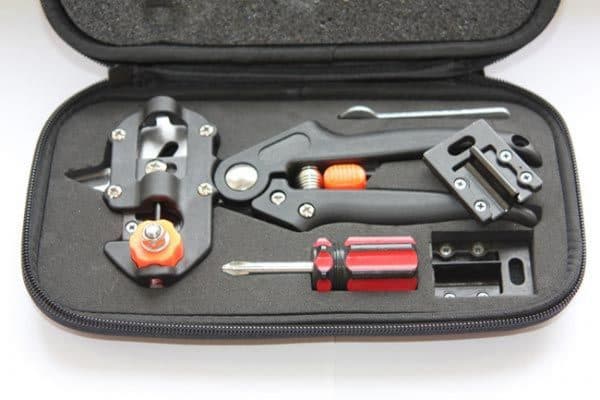
A set of pruning shears for grafting trees
With the help of such scissors, the same cuts are made on different shoots. They are neither level nor sloping. They are rather curly. By their appearance, they can in some way be compared with a tongue-and-groove connection system, that is, a "dad" and "mom" are obtained, which, when properly connected and fixed, take root perfectly. But success can be achieved only with a special shape and sharp sharpening of the tool, so that there is no splitting of plant tissues. During the grafting procedure, you may also need a pruner to cut tall trees.
What are the advantages and disadvantages of this tool? Among the advantages are:
- Ease of use - even a novice gardener can handle;
- Older shoots up to 13mm thick can be grafted;
- Durability up to 2-3 thousand cuts;
- You can carry out different types of grafts on different trees.
The last point was made possible thanks to the presence in the set of three types of blades - omega, U and V-shaped. You can choose the specific one for each case separately, thanks to which you can master and find your most optimal option for creating a grafting material. But there is also a certain drawback to this tool - it is a rather high price for such a limited application. Therefore, before buying, it is worth looking at whether it is needed specifically in your case.
You may also be interested in information about the rating of electric brush cutters.
The video shows how to use a pruner to graft trees:
Vaccine pruning shears care
In general, all the benefits described above will be available for a long time at the disposal of the gardener, if proper care is taken. There is nothing difficult in this, if you follow certain rules:
- The tool must always be clean and dry. After work, you must wipe it dry with a cloth and put it in a box or case, if provided by the manufacturer.
- If there is no cover or box, then the pruning shears are tucked into a dry soft cloth.
- After each work, the blade is also removed and wiped.
- Winter storage requires a separate approach. To prevent the formation of rust, it is necessary to lubricate not only the blades, but also the moving parts of the grafting secateurs. Next, fold it either into your own cover or into a dry cloth.
It is possible that the material on how to equip the landscape design of a small area will be useful to you.
In general, this is all the care that is required for a unit of this type. It is also worth excluding direct contact with water in order to extend the life of the tool.
If contact with water was, then it is necessary to wipe well and dry the instrument.After that, it is better to rinse it in gasoline or diesel fuel, and then lubricate it well.
But what kind of battery garden shears for grass are and how to choose and use them is detailed here.
How to use the tool
Cuts and grafting work are carried out according to the standard technology of grafting and budding fruit and berry plantations. To keep the tool in working order throughout the entire period of operation, it is imperative to provide the pruner with high-quality and timely, completely uncomplicated care:
garden tools must be kept dry and clean
Immediately after carrying out the entire volume of work, you need to wipe the blades and handles with a dry, clean cloth, and then put them in a case or a special case for storage;
it is important to strictly observe the rules of winter storage, which will prevent the formation of corrosive changes and reduce the sharpness of the cutting surfaces. It is best to lubricate the blades and all moving parts with a special lubricant, then wrap the tool in a clean, soft, dry cloth.
It is very convenient and profitable to use professional and amateur equipment from well-established manufacturers in your work. Unlike amateur knives, professional knives are always cold forged. The resulting vaccinations are distinguished by a high level of survival, and caring for this type of garden fixtures is not at all difficult, since even the procedure for replacing the knife is as simple as possible, and comes down to the need to untwist the minimum number of fasteners.
Why Buy the Professional Grafting Tool Grafting Pruner
This professional tree grafting tool is considered the benchmark for quality. Made of the best tool steel, by forging the blade, the knife does not dull as it goes into dense wood in oil. With the help of very thin forged V-shaped, U-shaped and Omega-shaped blades, it is possible to make curly cuts with shears for grafting trees and shrubs. The gardener decides which knife to use, depending on the density of the wood. The attachments change at the same time. They are double-edged and can withstand up to 3000 cuts. The tool has a 3 year warranty that does not cover consumables.
No less high quality and all other parts made of reinforced plastic and high quality steel. A special tool is required to sharpen knives, but there is no need for sharpening:
- each side of the blade can withstand at least 3000 cuts, and there are 2 of them on each nozzle;
- there are three attachments included with a professional grafting tool;
- the store always has replaceable attachments that are not expensive.
Belarusian grafting secateurs are made using tool steel for knives and steel 20 for holders and a handle, making them stronger. Aesthetics are given by silicone onlays. Zinc coating prevents corrosion of metal parts. Belarusian knives are of high quality, since the cutting part is forged, just like in Italian products. Such a grafting pruner costs 1,600 rubles, and is available to villagers with low incomes.
Choosing a grafting secateurs
The choice of a garden grafting knife should be approached with special care. Gadgets have become very popular in recent years.
Outlets offer several types of models from different manufacturers and at different prices. To choose the right tool, you should study all the subtleties and nuances, know exactly what to look for when choosing.
First of all, they look at the handles. The handles must be comfortable to use and made of a special durable material such as polyamide. Such handles will serve for a long time and are very convenient to use.It is better to refuse a device with handles made of aluminum, plastic or tubular steel.
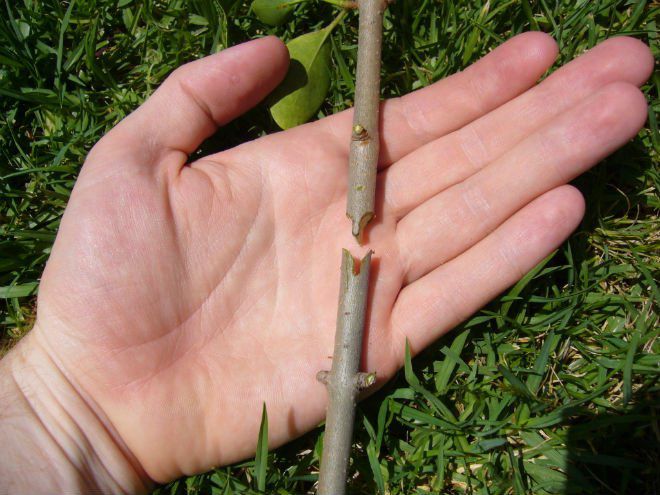 Grafting pruning shears
Grafting pruning shears
The next step in inspecting the grafting pruner is the blades.
You need to pay special attention to them. Knives should be made of good hardened steel
Such a blade remains very sharp for a long time, does not corrode and does not require regular sharpening. After working with a high-quality grafting pruner, the cuttings of the shoots remain perfectly even, smooth to the touch and do not deform.
The spring mechanism is also an important detail. It completely regulates the operation of the blades and is responsible for the quality of the cut. Before purchasing, you need to carefully inspect the structure from all sides. The parts of the tool must be well secured. During operation, no extraneous sounds should be heard and in a quality tool, the gap between the blades is always minimal.
The latest models of pruning shears are equipped with a step mechanism due to which the procedure for cutting the shoot takes place in several intermediate stages. When grafting is carried out on large branches, this function is very useful, since the use of pruning shears for grafting trees should be as convenient as possible.
The latest developments equip the tool with a lower pivoting handle. Such a mechanism reduces the efforts of the fingers, prevents the formation of calluses, and maximizes convenience during use. Thanks to this technical prudence, the hands do not feel tired even after long processing of the plants.
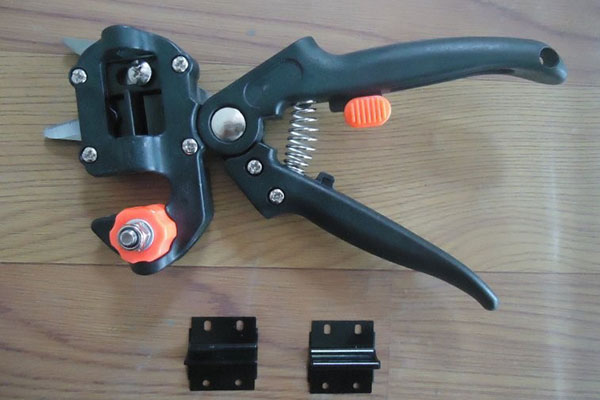 Grafting secateurs with replaceable blades
Grafting secateurs with replaceable blades
In order for the device to serve for many years, after use it must be cleaned of plant juices and adhering wood fibers that have fallen on the blade. A quality tool can be rinsed in water and then wiped dry. Secateurs of inferior quality should only be wiped with a rag.
Carrying out regular maintenance of the garden device, it is imperative to lubricate the springs of the mechanism, this protects the material from rust and increases the period of use. All other components of the instrument are also carefully examined and put in order.
Summing up, we can conclude that grafting trees with a grafting pruner of the latest developments is an interesting, extremely exciting activity even for inexperienced gardeners.
How to use a grafting pruner
The answer must be found in the instructions. Despite the fact that the device and the basic rules for operating this tool are the same, a particular brand may have its own nuances, which must be taken into account when working.
General instruction:
- Treat the instrument with a disinfectant solution (alcohol, for example). Make sure the blades are well sharpened.
- Make mirror grips for scion and rootstock trunks.
- With a sharp movement, applying maximum force, press the handles. Make sure the cut has been made.
- Unclench completely. Failure to do this while removing the barrel may damage the tool.
- Carefully combine the scion with the stock. Try to prevent bark separation.
- Cut off the excess part of the scion, which is located above the bud.
- Make a tight bandage with a special grafting tape at the cut site.
- Cut off excess branches on the rootstock.
- Apply garden varnish to open cut areas.
- Clean up tool. Wipe dry. Treat with machine oil, special grease or lithol.

Many people make a mistake at this stage - they wash the grafting secateurs. If it’s an expensive Italian brand, there’s nothing to worry about. Rinsed with cool water - wiped dry - and you can use it further. However, for cheap Chinese models, it will be like death. Spring mechanisms can corrode heavily.
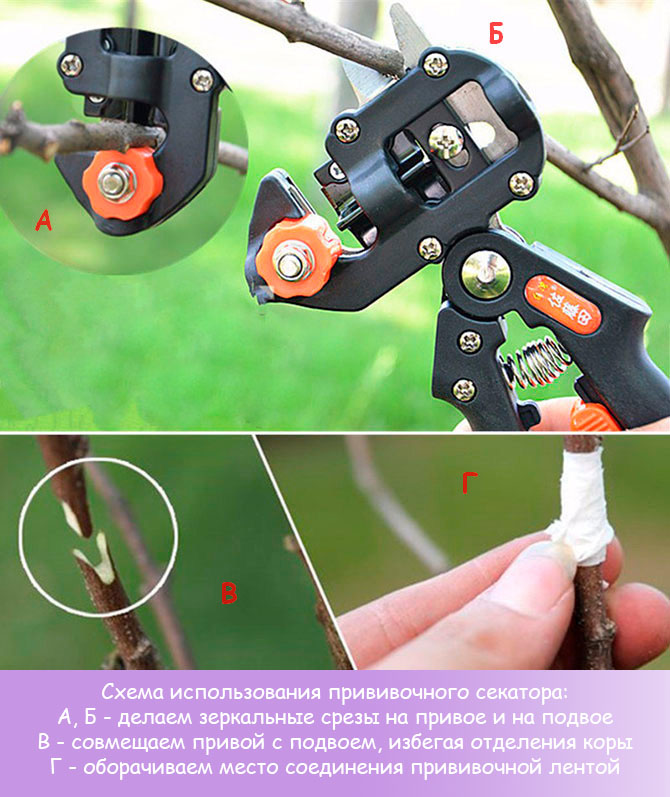
Additional operating tips:
- store in a dry place;
- do not leave for a long time outside, in the rain;
- periodically sharpen the blades, clamping the pruner in a vice and leading the bar in only one direction;
- do not use the grafting secateurs as usual (for pruning cuttings, old, dry and thick branches).
Better to watch a video preview of how the pruning shears work. This will allow you to clearly see how to do everything correctly, not harm the plant and extend the life of the tool.
Types of secateurs for working in the garden and in the country
Secateurs are used to work with various horticultural crops. All models are subdivided according to the purpose and principle of the mechanism.
Types by appointment
The nature of the work determines the design and sharpening of the blades, the length and configuration of the handles of the garden tool. According to the purpose and scope of application, secateurs are divided into types:
- Grafting - have curly knives for instant creation of mirror-accurate cuts on the scion and rootstock.
- Versatile - suitable for cutting garden crops.
- For florists. These scissors have both blades sharply sharpened.
- For working with roses and other thorny plants - they have devices for protection against thorns.
- For pruning vines. Professional tools in this group are often equipped with a trigger pistol grip and battery.
- Loppers are powerful, with long, often telescopic, handles.
- Lawn - for cutting grass in hard-to-reach places. They have adjusting wheels to maintain a predetermined distance to the ground.
Special pruning shears are essential for narrow-minded professionals. A gardener-summer resident will need two or three universal ones: for grafting and pruning garden crops.
For the correct choice of garden tools, you need to know the principles of operation of mechanisms of different designs.
Types of the mechanism of work
According to the structure of the mechanism, planar (bypass), contact (persistent) and garden shears are distinguished.
In garden shears, both blades are sharpened on one side and move in a plane towards each other. Scissors cut thin branches, young shoots, thick grass stems.
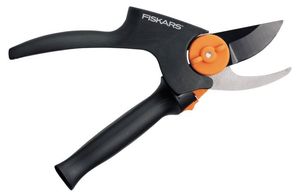 The pruning shears with a planar mechanism are considered universal. They carry out almost all work on pruning the branches of garden plants. The blades are crescent-shaped, which prevents the branch from slipping out when cutting. The supporting blade is stationary and not sharpened, and the sharpened working blade slides along the plane.
The pruning shears with a planar mechanism are considered universal. They carry out almost all work on pruning the branches of garden plants. The blades are crescent-shaped, which prevents the branch from slipping out when cutting. The supporting blade is stationary and not sharpened, and the sharpened working blade slides along the plane.
Contact pruning shears are designed for cutting sturdy, dry and thick branches. The double-edged working blade cuts the branch like a guillotine. The abutment blade has a platform - "anvil" or "abutment lip", located perpendicularly and pressing the branch during the cut.
In addition, ratchet pruning shears should be noted. Both planar and contact tools have such a mechanism. Ratchet - toothed knot. With its help, a thick branch is cut in several stages. The knife stops in the thickness of the branch until the next pressing on the ratchet lever. An incision made by a ratchet pruner is flat no matter how many times it is made.
To trim the shoots and branches of trees, you must have at least a couple of tools. The first is a classic plane, the second is a contact with a ratchet mechanism.
Advantages and disadvantages
The product has many advantages, and some have already been described. Here are some more pros:
- Grafting a tree takes only a few minutes, which means that a large number of plants can be processed in a day.
- Due to the lack of adjustment of the sections, they do not have time to dry out.
- Not only thin, annual shoots, but also older ones can be grafted.
- Modern high-quality materials from which secateurs are made allow the use of tools from year to year with the same efficiency.
- A set of interchangeable knives allows you to use the tool for different trees.
Only shoots of the same width can be processed with a grafting pruner, a difference of only a couple of millimeters is permissible, otherwise you will have to use a knife. If the shoots are the same thickness, but thinner than 4 mm or thicker than 12 mm, grafting will also fail due to the limited capacity of the pruner.
How to make a grafting pruner with your own hands: drawings and manufacturing steps
To make a grafting garden tool yourself, you will need competent drawings, as well as some skills and blanks. It is popular to make a grafting pruner from a common garlic. The main problem of creating a tool based on such a device is the need to independently grind knives or order from a locksmith. No less popular is the manufacture of so-called grafting vices.

As a basis for such a tool, you need to take a small vice and fix a sharp and curved blade on the pin. Cutting is carried out not during pressing, but by turning the handle. Work with such a homemade pruner is longer, but no less convenient and effective.
Professional pruning shears for tree grafting
In most cases, the market for grafting secateurs is represented by professional tools with high quality characteristics and a well-thought-out working mechanism, as well as semi-professional and amateur tools designed for a small backyard farm.
Nevertheless, in recent years, amateur gardeners are increasingly faced with outright fakes, so it is important not only to familiarize yourself with the rating of the highest quality models, but also to know how much a high-quality and durable tool costs. The price of a high-quality professional device cannot be less than two to three thousand rubles.
|
Model |
Characteristics and application features |
|
Professional Grafting Tool |
The delivery is carried out in different configurations, as well as with a screwdriver for changing knives, which are made of high-carbon steel SK-5 and are distinguished by a chrome-plated wear-resistant and anti-corrosion coating. The handles are made of reinforced plastic. The Belarusian analog instrument is slightly cheaper |
|
Artitec-3T |
Allows you to provide the ideal curly trimming of the rootstock. Ideal for crown grafting on plants up to 4.5 cm in diameter.Forged knives are made from modern high-carbon steel alloy |
|
Artitec Manual Grafting 3T AR-INN3T |
The main difference from the previous model is a special knife that allows budding or kidney grafting. The cost of the tool is quite high, due to the manufacture of knives from high-quality high-carbon steel |
|
Artitec complementary gtafte |
Ideal for grafting thin cuttings and is more often used as an additional gardening tool. It is used for cuts on the rootstock or when performing grafting in the "split" method |
|
Due Buoi 303/21 |
The Italian model of the grafting pruner allows you to get perfect cuts without the use of significant effort. The device is equipped with very sharp forged knives of three types: U-shaped, Ω-shaped and kidney. Ideal for work with shoots up to 1.1 cm in diameter |
How to make a grafting secateurs
Craftsmen did not stay away from the development of progress. Not having the desire or financial ability to purchase a high-quality tool, they began to make it on their own, remaking a garlic or a vice for these purposes. Simple drawings have been developed, according to which you can easily understand the design of the product, its configuration and the principle of operation, as well as take part in the improvement of homemade grafting secateurs.

Diy grafting pruner
To make a tool from an ordinary manual garlic, you will need to find a spring that can create the necessary force, as well as make knives yourself. You can re-equip a small vice, to the pin of which a curly blade is attached, the trimming itself is carried out by rotating the handle and the resulting pressure.

